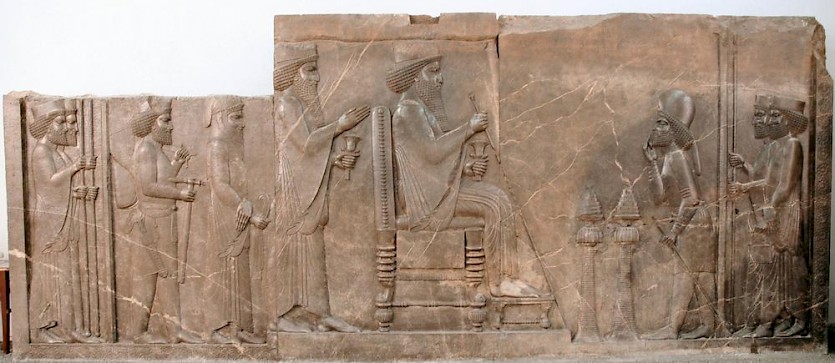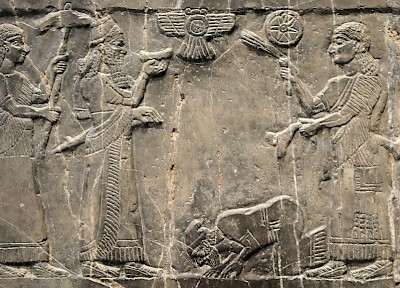Proskynesis
Proskynesis: Greek name of the ritual greeting at the eastern courts.

The first to describe proskynesis ("kissing towards") was the Greek researcher Herodotus of Halicarnassus, who lived in the fifth century BCE. He writes:
When the Persians meet one another in the roads, you can see whether those who meet are of equal rank. For instead of greeting by words, they kiss each other on the mouth; but if one of them is inferior to the other, they kiss one another on the cheeks, and if one is of much less noble rank than the other, he falls down before him and worships him.note
What Herodotus describes as a gesture he has seen in the streets, was ritualized at the oriental courts. Depending on his rank, a visitor would have to prostrate himself, kneel in front of, bow for or blow a kiss to the king.
To the Greeks prostrating, bowing or kneeling were unacceptable. In their view, these acts were only allowed in front of a god. Therefore, they thought that the Persians - the only oriental court they knew - venerated their kings as god. Seen in this light, the word "worship" in Herodotus' text becomes logical. (It is also interesting to note that Herodotus, who was something of a relativist, does not object to the custom.) A similar hesitation can be discerned in the Jewish book Esther.note

At the Achaemenid court, the proskynesis ritual could be very complex. At least three important aspects can be discerned.
- The great god Ahuramazda had created, as the Persians said, all kinds of people and had given them one king. Therefore, it was unthinkable that all these kinds of people, the differences between which were according to the wishes of the supreme God, should greet His representative in the same way. The complexity of the ritual was natural. It showed that there was "one king for many nations".
- At the same time, the proskynesis ritual meant that the empire was not a melting pot in which all particularities disappeared; in his contacts with the king, everyone had to make the gestures and wear the array of clothes that were fitting for his social position and ethnicity.
- Finally, it was a status symbol. You receive a lot of symbolic capital when you are able to discern all kinds of important distinctions in an essentially simple ritual like greeting.
In the summer of 327, the Macedonian king Alexander the Great provoked great unrest among his courtiers when he introduced proskynesis. By then, he had conquered the Achaemenid Empire, and many Iranians were serving at his court. If Alexander wanted their support, he had to act like a Persian king, and therefore, he ordered everybody to behave according to the oriental court ritual.
There was much opposition (text) and it is not clear whether Alexander succeeded. However, proskynesis was common practice at the courts of his successors. In fact, we still bow for our kings and queens.